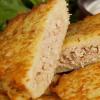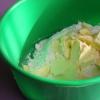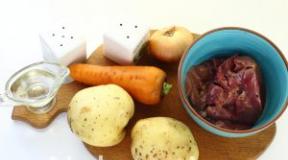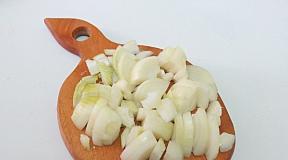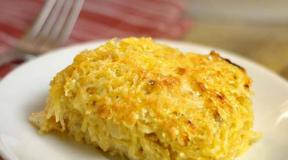What is the difference between oysters. What's inside the shell
Oyster- This is one of the many seafood that belongs to the family of marine molluscs. There is no person who has not heard of the use of oysters in cooking. Oysters can be eaten not only in restaurants and cafes, they can also be cooked at home, since there are a large number of all kinds of recipes for their preparation.
If we talk about where oysters are found, then the seas in the tropics are considered their habitat. Oysters do not like too salty water, which is why they can sometimes be seen in rivers.
As for the offspring, the oysters spawn, and they begin to do it in the spring. The spawning period can last up to six months, ending by the end of the summer period. For a favorable roe throwing, oysters need rather warm water. The most interesting thing is that the eggs remain in the oyster until they are fertilized and hatch. Thus, already born mollusks emerge from the shell, which move around the reservoir until they find a suitable place to attach to it and begin their life.
The most valuable and high quality at the moment are Norwegian oysters, which are collected in natural Norwegian waters. Also on the market you can find oysters from other countries: Japan, USA, South Korea and others.
When choosing oysters, you should pay attention to their freshness. Fresh oysters should have a solid color. Their sashes must necessarily fit snugly to each other, without even having the smallest crack (see photo). If you notice a small slot between the shutters, this means that the oyster is stale, and it is better not to use such shellfish as food, otherwise, you can get serious poisoning.
Types of oysters
Today, about fifty different types of oysters are known, most of which are edible. Formally, all types of oysters are divided into two types: flat and deep.
The flat-faced oyster includes four distinct varieties of shellfish that differ in taste, appearance and market value. The flat type of oysters includes the following varieties:
- The most sought-after flat oysters by gourmets are Maren Oleron... They have a very delicate structure, rich taste and delicious aftertaste. They are the most popular representatives of this type of oyster.
- Belon Is another type of flat oyster that is harvested in the French province. It differs from its relatives in appearance, color in light gray tones, and also has a rather pungent odor.
- Bouzigues Is a type of flat oyster found only in the Mediterranean. They differ from other types of oysters in that, when eaten, they emit a spicy aroma, and they also have a pronounced salty taste.
- The yellow-green shell and small size characterize the type of oyster called Gravette... Unlike its relatives, this type of mollusks, although not large in size, has a very fleshy body.
Deep oysters are mainly collected only within the Pacific Ocean. This type of oyster is usually divided into two categories: gourmet and special. Gourmet ones have a slightly smaller amount of juice and meat than special ones, which differ significantly in price.
It is customary to grow this type of oyster in special tanks, which are filled with special algae. Keeping oysters in such tanks improves the quality of the oyster. The deep look of oysters comes in five varieties:
- The highest fat content and light salty flavor characterizes oysters. Fin de Claire... They are contained in tanks and supplied with algae as an additional source of nutrition.
- Oysters that are larger and also contain more meat are called Specialist... This type of oyster is kept in tanks for up to two months in order to saturate the oyster with the necessary elements.
- Blue Oyster differs in a specific color, which is achieved by keeping mollusks in a special aquarium, which includes blue clay. Thanks to her, this type of oyster contains a huge amount of useful trace elements.
- Croesus Is an Irish type of oyster that is characterized by high fat content and high meat content.
- Oysters, which differ from their counterparts in a rather graceful shell shape, as well as a sweetish pleasant aftertaste, and the smell of iodine, are called White pearls.
The maximum known size of this type of oyster is 50 centimeters. But such individuals are very rare. On average, the size of deep oysters varies between 5-20 centimeters.
Those who have come across oysters know that opening them is not as easy as it might seem at first glance. First of all, it is necessary to clarify that in no case should you open oysters with hammers or any other objects that can injure the shell, otherwise you can spoil the taste of the oyster.
To open the oyster correctly, you need to arm yourself with a small sharp knife, or even better with a scalpel, and carefully draw along the line of connection of the shell valves. This will cut the muscles of the clam that hold the shell back, allowing you to open it up. 
If you decide to visit a French restaurant, then you should definitely try the oysters! If you don’t know how to eat them correctly, it doesn’t matter! We will enlighten you in this matter.
To begin with, I would like to note that if you decide to cook and taste oysters at home, then they are served on a tray in a multiple of six. There should also be fresh lemon wedges on the tray to add sophistication to the dish. Oysters should definitely be served with white wine, since only in combination with this drink can oysters reveal their full taste.
If you are going to eat oysters in a restaurant, then first you need to make sure that the oyster is fresh. It is very simple to determine this: the flaps of the sink must be closed. As a last resort, they open right in front of visitors to showcase the freshness of the oyster. Do not order or consume oysters that have already been opened, as they may be spoiled.
And eating oysters correctly is very simple: take an open oyster shell in your left hand, and a two-pronged fork in your right hand, which is designed for this purpose. The teeth of the fork should be brought under the body of the mollusk, and then gently remove it from the shell. The oyster can be dipped in the served oyster sauce, or you can apply it directly to the clam while it is still in the sink. It is also customary to sprinkle oyster meat with lemon juice before eating.

You can't chew an oyster. It is swallowed in one stroke and then washed down with white wine. It is also not customary to drink the liquid from the oyster shell. There may be sand if the oyster was caught during a storm.
Cooking secrets
To learn how to properly cook oysters, you should clarify that you only need to buy fresh oysters with tightly closed shells.
If you already have fresh raw oysters on hand, then you can start cooking. There are a lot of recipes for cooking oysters. They can be added to salads, served as a separate appetizer, or complemented with other dishes.
Most often, oysters are cooked using the baking method: due to the content of juice in the shell, the oyster is baked in it, and then served. Before baking, the sink must be free of dirt and algae! Also, for cooking oysters, the method of stewing in the shell and without it is used. 
Oyster meat can be cooked and fried by especially enterprising people, but this is not entirely correct. The best way to cook oysters is the baking method, adding aromatic spices to taste.
Beneficial features
There is no doubt about the beneficial properties of oysters. Like most of all seafood, oysters have a beneficial effect on the human body, helping it to strengthen the immune system and even get rid of some diseases. So, oyster meat has a good tonic effect, and also, due to the content of various amino acids in it, it can neutralize the development of cancerous tumors. Also oysters able to enhance sexual desire, being one of the best aphrodisiacs.
The harm of oysters and contraindications
The harm of oysters is rather doubtful. Oysters can only harm people who are allergic to them and seafood in general. There are very few contraindications for oysters: it is not recommended to use them only for people with allergies, as well as for pregnant women in the last stages of pregnancy. Also, oysters can be harmful if they are stale.
Composition
The composition of oysters can be envied by most of the seafood. Oyster meat contains elements such as proteins, fats, glycogenic carbohydrates, as well as a large amount of vitamins, in particular, there are a lot of B vitamins in them.
As for minerals, oysters contain iodine, potassium, calcium, zinc, phosphorus, iron and copper. With all this, the amount of mineral content in oysters is so high that six oysters will be enough to replenish the daily supply of minerals for the body.
Among other things, oysters contain amino acids and saturated fatty acids, such as omega-3, which, when consumed regularly, can have a positive effect on the immune system, as well as fight the growth and spread of cancer cells.
Oysters and mussels: differences
Most molluscs with shells are very similar to each other, and oysters with mussels are no exception. Many people ask the question: "What is the difference between oysters and mussels?" In fact, everything is very simple:

Among other things, oysters and mussels vary greatly in price. Mussels are rightly called oysters for the poor. But if we discard all the shortcomings, then the composition of mussels is practically no different from the composition of oysters.
Especially in our country, where this wonderful seafood comes mostly frozen. The main thing is to learn how to choose high-quality mussels and be able to cook them. And you can make anything from shellfish - light salads, delicious pasta, soufflé, soup or risotto.
Appreciated for ...
Mussels are good for both ladies and their life partners. The former appreciate them for their extremely low calorie content: if a piece of pork or lamb weighing 100 g on average pulls 250-300 kcal, shellfish meat gives only 50 kcal (even shrimp has a higher calorie content and is about 80 kcal). Therefore, you can safely enjoy the good taste and delicate texture of the mussel and not be afraid to spoil your figure. For men, this seafood is also incredibly healthy and is a real aphrodisiac.
It's all about the unique shellfish meat, which almost does not contain carbohydrates, but has a high concentration of high-quality protein, vitamins B and E (the latter is called by professionals "bearing offspring"), polyunsaturated fatty acids omega-3, iodine, calcium and magnesium. At the same time, mussels have little cholesterol and a lot of phospholipids, which have a beneficial effect on liver function. In general, this seafood is incredibly healthy, so try to include it in your menu periodically. True, do not forget that poisoning by sea reptiles is one of the worst, so choose mussels very carefully for your culinary masterpieces.
Shellfish farm
The mussel, beloved by many gourmets, is found in almost all of the world's oceans, but mass industrial production is carried out only in some parts of the world. For example, seafood “comes” to our country from China, New Zealand (large green “kiwis” are just from there), there are some Spanish and French products, and almost 50% of shellfish comes from Chilean Patagonia - the southernmost and least populated region of Chile. washed by the cold waters of the Pacific Ocean. The cultivation of mussels on farms is as follows: the fry are grown a little and sent to the ocean, where they hang on ropes like giant bunches of grapes and build up their mass within 8-15 months. At the same time, seafood is not fed with anything - it grows in natural conditions, constantly filtering the water and feeding on valuable plankton. Then the grown mussels are taken out of the ocean and subjected to two procedures: canned or scalded with hot steam and frozen.
Rather dead than alive
If you are lucky enough to buy fresh mussels, make sure that all shells are closed. If they are ajar, it means that the mollusk is rather dead than alive. You can even tap the shell with your finger - if it reacts and shrinks, then everything is "ok", if not - such seafood is dangerous for your stomach. Another important indicator of the freshness of the sea reptile is the absence of a specific smell. Professionals say that good mussels should smell only of the sea. However, in our country, mussels are sold mainly in a boiled-frozen state, therefore, it is possible to understand whether they are fresh or not only after defrosting. So, before cooking, take them out of the freezer, thaw them at room temperature and smell them thoroughly. If you feel even a slight smell, it is better to refuse the delicacy.
In the sink or not?
Unlike shrimp, which can vary in size, mussels do not have a wide variety of shapes. There are large delicacies (35/40), bearing the fruit name "kiwi", and there are medium-length mollusks, of which there are 40 to 60 pieces per kilogram - they are the most popular. You can buy seafood in a whole shell (it is steamed and vacuum packed), in a half shell or a clean fillet. In any case, mussels should not be covered with a very thick layer of ice, and even more so they cannot have snow and yellow deposits - this indicates that the product was thawed and re-frozen. The clam meat should be light, voluminous, firm and have an excellent presentable appearance (black and flabby fillet indicates the old age of seafood). If you buy canned food or preserves, before buying, be sure to study brine - the brine in which mussels swim. It must be absolutely transparent, it cannot contain blood clots, mold and other foreign inclusions. Do not forget to also check the integrity of the packaging so that the oil does not leak out of the plastic can and the vacuum bag is not torn. The label on the jar should be glued evenly and carefully, and all information on it should be stated clearly and understandably. If it is impossible to read the composition of the product, the letters blur and the piece of paper is kept crooked, then, most likely, such preserves were made in an underground workshop (they are usually prepared from thawed mussels).
Fillet soufflé
Considering that almost all the mussels that are on our counters are already cooked and ready to eat, they do not need to be steamed and fried for a long time. One has only to unfreeze and immediately put into action. You can make delicious mussel pizza, pasta in tomato or cream sauce (seafood loves both dressings), make Spanish paella, or cook soup with other seafood and fish. It also turns out very tasty clam fillet soufflé, which is very popular in countries that produce healthy seafood. To make it, first fry 1/2 chopped onion and 3 crushed garlic cloves in butter. Then add 1/2 sweet pepper, dry paprika, pour in 300 ml of dry white wine and boil for 5 minutes. After that, put in a saucepan 1 kg of mussel meat, 400 ml of cream, 200 g of bread crumbs and simmer the souffle for 10 minutes over low heat. The prepared mixture of salt and pepper, pour into clay pots or cocotte makers, sprinkle with grated Parmesan on top and send to an oven preheated to + 180 ° C for 10 minutes. The soufflé will be covered with a golden crust and will be ready for tasting.
Shell under cheese
If you manage to buy large or medium-sized mussels in half-shells, it is best to simply bake them with garlic and cheese. To do this, first defrost the clam at room temperature. While the valuable product is thawing, make green garlic oil by thoroughly mixing 100 g of softened butter, 1/2 teaspoon of salt, 2-3 crushed garlic cloves and a handful of chopped fresh parsley and basil. Then put the resulting creamy mixture on each mussel in a shell, sprinkle it with grated cheese on top and bake it in the oven for 10 minutes at + 180 ° C. Such an easy-to-prepare dish can become a real sensation at any family celebration.
Clam salad
If you bought not boiled-frozen, but canned mussels in oil or your own juice, you can make a wonderful light salad from them. Take any green leafy salads (rucola, lettuce, frieze, iceberg) as a basis, add canned green peas, fresh bell peppers and cucumber to them. Season all this with olive oil and top with mussels without liquid and slices of boiled eggs. In general, canned shellfish meat can be safely combined with any other ingredients: white cabbage, boiled rice, various seafood, fresh vegetables and use mayonnaise instead of vegetable oil as a dressing.
5 secrets of making mussels
1. The best companion for mussels is white wine. They can be washed down with dishes or used to prepare "mussel" treats.
2. The best way to cook mussels is to use sea salt. The main thing is to remember that seafood already contains a certain amount of salt, so do not oversalt your dish.
3. Don't be afraid to combine lemon juice with any seafood, including mussels.
4. The best sauce for mussels is extremely easy to prepare. You need to mix olive oil, lemon juice, garlic and herbs.
5. Mussels are combined with absolutely all products - vegetables, dough, meat, chicken, fish and other seafood. However, true gourmets believe that it is best to cook shellfish alone so that other ingredients do not overpower their taste.
The waters of the oceans are inhabited by a wide variety of creatures. Some of them, mussels, have long been recognized as tasty and healthy food, despite their unsightly appearance. Initially, they were used as food by poor fishermen who could not afford beef and pork. Later, the nobility tasted the unique delicate taste of these, and mussels appeared on rich tables, complementing an extensive diet. Many people neglect these seafood due to their specific look and texture. In this article, we will look at the beneficial properties of these bivalves, their significant differences from oyster molluscs and their effect on the human body.
Calorie content and nutritional value
It is an ideal product for those who are in good physical shape. Every 100 grams of these shellfish contains total 77 kcal.
 The content in them is huge - 12% of the total mass of the mollusk. in 100 g, only 2 g, and almost all of this volume is occupied by polyunsaturated, which are only beneficial for the human body.
The content in them is huge - 12% of the total mass of the mollusk. in 100 g, only 2 g, and almost all of this volume is occupied by polyunsaturated, which are only beneficial for the human body.
Important! These shellfish are strong allergens, so only those people who do not have a tendency to food allergies can eat them.
Vitamin and mineral composition
The benefits of seafood
There are controversies surrounding this food product. Some people believe that high-protein mussel meat is becoming irreplaceable. a source of proteins and amino acids in the human diet. Others avoid this product, since mussels, in obtaining food, pass the surrounding water through their body. This leads to the accumulation of toxins and heavy metals from the environment in their pulp. 
For men
The work of the nervous and muscular systems depends on the intake of vitamins and minerals in the body, in particular. Mussels are a reliable source of these vitamins. They strengthen muscle connections, establish neural connections, therefore, the male body is recovering... Zinc is responsible for hormonal balance. It increases the amount of the male hormone testosterone in the blood. A man who regularly consumes these shellfish improves spermatogenesis.
Did you know? For the first time, oysters were included in the official classification of marine organisms in 1758. In 1822, they were assigned a separate detachment among bivalve molluscs. It is noteworthy that they have been known to mankind for a long time. Twelve thousand years ago, American Indians ate them, deliberately growing them on homemade river and lake farms.
Organic folic acid is responsible for metabolic processes in the cells of the tissues of the human body. It normalizes them - the genetic information is more reliably protected, the likelihood of healthy offspring increases. Iodine, which is found in excess in mussels, is responsible for the proper functioning of the thyroid gland. The thyroid gland protects the male body from pathogenic viruses and microorganisms, inhibiting their activity as the blood is filtered.  These molluscs have the most significant effect on male sexual function. They improve blood circulation in the reproductive system, sperm quality and increase libido. The walls of the vessels are strengthened, the blood supply to the cavernous bodies of the genital organ is more intense, and the erection is enhanced. The prostate gland or prostate, which is partly responsible for the production of sperm, is restored - this is an excellent prevention of prostatitis in adulthood and old age.
These molluscs have the most significant effect on male sexual function. They improve blood circulation in the reproductive system, sperm quality and increase libido. The walls of the vessels are strengthened, the blood supply to the cavernous bodies of the genital organ is more intense, and the erection is enhanced. The prostate gland or prostate, which is partly responsible for the production of sperm, is restored - this is an excellent prevention of prostatitis in adulthood and old age.
For women
The effect of mussels on the female body is similar to their effect on the male body. Iodine, which is part of the pulp of mussels, strengthens its own, reduces the level of harmful by increasing the level of useful. The low calorie content of these shellfish, as well as their ability to speed up metabolism, helps to quickly get rid of extra pounds on a specially designed diet.
The vitamin composition of these seafood contributes to beauty, skin health and strength. Vitamins and improve complexion, get rid of mimic, strengthen tooth enamel, etc.  The mucous tissues of the female reproductive system regenerate faster, and the uterus will be ready for embryo implantation if you eat mussels preserved in oil every two days. In addition, increased sex drive increases the chances of a good conception.
The mucous tissues of the female reproductive system regenerate faster, and the uterus will be ready for embryo implantation if you eat mussels preserved in oil every two days. In addition, increased sex drive increases the chances of a good conception.
Important! The protein contained in the pulp of these molluscs is decomposed during fermentation into acids, which negatively affect the elasticity of the cartilage tissue. This food is contraindicated for people suffering from arthritis.
How to eat mussels
From an unfamiliar exotic delicacy, this food has turned into a familiar dish, but you need to know how to handle it. Mussels are not the most convenient food, so practice before eating them in public. The ready-made pulp is already served in restaurants cleaned and processed, you can take it off the skewers and eat it right away. Order from drinks, as an option - white wine.
If you got unrefined shellfish, then tongs and a fork must be served with them. The tongs should be held in the left hand and the fork in the right. Squeeze the clam with them and remove the pulp with a fork. You can rinse it in a special bowl of acidified water and only then eat. Soup with shells is eaten in much the same way. First, catch, peel and eat all the clams, and then spoon out the broth with a spoon.  Raw meat can be eaten without a fork. Take open clams in your hand and suck them out of the shell with a sucking motion. In order not to chomp while doing this, practice a couple of times on homemade clams. Pay attention to the liquid that accumulates in the pulp and, when opening the shell, can spray you, the tablecloth and those sitting next to you. This food should not be hastily handled.
Raw meat can be eaten without a fork. Take open clams in your hand and suck them out of the shell with a sucking motion. In order not to chomp while doing this, practice a couple of times on homemade clams. Pay attention to the liquid that accumulates in the pulp and, when opening the shell, can spray you, the tablecloth and those sitting next to you. This food should not be hastily handled.
Is it possible for pregnant and lactating mothers
This product has different effects on pregnant and lactating women. It is worth noting that infants are especially prone to allergic reactions, therefore, nursing mothers with this product need be careful... Until the child is six months old and his immunity is not strong enough, do not eat these seafood.
After six months, introduce mussels gradually. Eat a few shellfish and watch your baby's reactions throughout the day. If he develops an allergic rash or redness, skip the shellfish for another two to three months. If the reaction is negative, you can increase the portion.
Pregnant women these seafood shown for use... As a source of complete, easily digestible protein and essential amino acids, they serve as a good addition to. Mussels for pregnant women should be of exceptionally high quality. Always check them for freshness and ask the seller for a certificate of sanitary inspection.  These mollusks filter water, passing both useful and toxic substances through themselves, and some of them accumulate in their pulp. Unscrupulous producers can feed mussels with food waste instead of quality feed. Such products will not bring any benefit.
These mollusks filter water, passing both useful and toxic substances through themselves, and some of them accumulate in their pulp. Unscrupulous producers can feed mussels with food waste instead of quality feed. Such products will not bring any benefit.
In any case, pregnant and lactating women are prohibited from eating raw mussels. Be sure to boil them or steam them for at least twenty minutes. So you exclude the possibility of infection with infectious diseases and worms.
Did you know? In a day, this sea creature is able to pass through itself up to eighty liters of water. Given the tiny size of its body, such a capacity is comparable to the powerful dams of a hydroelectric power station.
What is the difference between mussels and oysters
First, they are distinguished from each other. appearance
... In mussels, the shell is small, black, smooth, occasionally overgrown with other mollusks, and they grow in rosettes, attaching themselves in rows. Oysters have a slightly deformed shell, similar to limestone deposits, and are attached to stones in layers - smaller on larger ones. Mussels can move, which distinguishes them favorably from oysters that settle in one place, even if it is polluted, for life. Mussels have a muscular leg that moves their shell and body over rocks.  Their nutritional value practically does not differ, but they contain more in mollusks with a black shell, and in limestone ones -. Both seafood and others are consumed raw, but mussels are more dangerous in this regard, since they feed on everything, including toxic waste. They should not be consumed by allergy sufferers, and oyster shellfish provoke digestive problems in people suffering from peptic ulcers. The price is also different - oysters are more valuable.
Their nutritional value practically does not differ, but they contain more in mollusks with a black shell, and in limestone ones -. Both seafood and others are consumed raw, but mussels are more dangerous in this regard, since they feed on everything, including toxic waste. They should not be consumed by allergy sufferers, and oyster shellfish provoke digestive problems in people suffering from peptic ulcers. The price is also different - oysters are more valuable.
Contraindications and harm
The negative effect of these seafood on the body is due to their specific composition. They are not recommended for people with diseases of the joints and vertebrae, since the protein they contain is processed in the body into uric acid. The acid crystallizes after synthesis and is deposited as a solid phase in the cartilaginous tissues, provoking pain.  Allergy is another reaction to the protein component of oyster pulp. It is not only straight, but also cross-linked, which means that mussels can harm those who are allergic to wheat protein.
Allergy is another reaction to the protein component of oyster pulp. It is not only straight, but also cross-linked, which means that mussels can harm those who are allergic to wheat protein.
These shellfish filter the water in which they live and accumulate various kinds of toxins. If grown in industrial areas with polluted waters, their meat will contain a high percentage of saxitoxin, which has a paralyzing effect on the nervous system. Therefore, it is so important to buy seafood from a trusted supplier, avoiding Korean and Chinese products.
Did you know? Japan has given this seafood significant symbolism. In Japanese culture, the reliably connected shells of the shell signify a strong union of lovers who create a young family. No wedding celebration in the Land of the Rising Sun is complete without the traditional mussel soup.
The benefits of these seafood can hardly be overestimated. Their unique vitamin and mineral composition is balanced and provides a person with everything he needs. The protein component is easily absorbed, which is beneficial for people with impaired digestion and those who are recovering from a long illness. Mussels have a positive effect on the sexual function of both men and women, increasing the likelihood of a desired conception and a successful pregnancy. Careful selection of a quality product and proper heat treatment will ensure that these shellfish taste good and make them frequent guests on your table.
Today, mussels and oysters are the most popular shellfish found in the cuisines of almost all nations of the world. No one has reliable information about when and under what circumstances they began to be eaten by humans. It is only known that it happened a very, very long time ago. Historians and archaeologists claim that they have evidence of primitive man's gathering of molluscs dating back to an even older time period than evidence of his fishing and hunting. However, modern people are interested in several other questions. For example, how do mussels differ from oysters, which shellfish are tastier and healthier for humans, how to properly cook seafood, etc.
Well, we will try to give answers to these questions, and also introduce the reader to some interesting facts about these sea mollusks.
Many people do not differentiate between mussels and oysters. But they are completely different marine molluscs. So what are mussels and oysters, how to tell them apart? Now let's look at this issue.
Appearance
To begin with, it is worth noting that the appearance of these marine life is completely different. So, oysters are larger than mussels. Their shells are somewhat rough, and wavy at the edges. Oyster shells are characterized by a flat or slightly concave shape. Mussels, in turn, have a much smaller shell. Their shape is also completely different: more rounded, with sharp edges. You can also distinguish mollusks among themselves by the color of the shell. Oysters are generally fairly light in color, while mussels are dark gray to almost black. The presence of this or that shade depends on the quality of the water in the reservoir in which the molluscs live.
Lifestyle
You can understand how mussels differ from oysters if you consider the lifestyle of some and other mollusks. So, oysters are unable to move. They spend their entire lives "sitting" in one place, attaching their entire shell to rocks or other hard rocks present on the seabed. Mussels are able to change their location. A special thread (byssus) allows them to do this. With its help, mussels are attached to any immovable objects and travel in search of food at the distances that the thread allows.

Considering the existence of mollusks in communities, one more feature can be noted that distinguishes these two species. If mussels prefer to lead social life, attaching themselves in a row one after another, then oysters live in "heaps", sometimes tightly cemented with each other.
How are mussels different from oysters? What's more useful?
Both one and the other have a very high nutritional value for the human body. Both oysters and mussels are good cancer prevention measures. This property is due to the high content of elements such as sodium and fluoride in marine molluscs.

The difference between oysters and mussels lies in the way they are prepared. More precisely, in the fact that the former cannot be cooked by means of heat treatment, and the latter must be obligatory. This is because oysters are a cleaner product. They are eaten raw. And mussels, due to their more active vital activity, accumulate in themselves a dangerous dose of harmful substances that go into the water after boiling.
Price
Perhaps the main criterion for how mussels differ from oysters (photos of both species are presented in the article for clarity) is their cost.

The latter are quite expensive and, as a rule, are served only in some restaurants in our country. And mussels can be found on sale quite often. Almost in every store you can buy these mollusks frozen at a fairly affordable price.
How to choose?
Perhaps these were the main nuances that allow even the most distant person from high cooking to figure out what is the difference between mussels and oysters. Now we will consider some more important points that relate to the methods of preparation and rules for eating such mollusks, of course, taking into account the differences that were given above.
It is believed that fresh mussels and oysters, which remained alive until frozen, have closed shells. And they open after they die. This should be considered when choosing mussels and oysters in the store.
Treatment
After purchasing sea molluscs, you need to process them as quickly as possible. Of course, in the case of frozen ones, you can postpone, but if the mussels were bought live or even chilled, you must immediately start cooking them. First you need to open the shells, turning them with the sharp side towards you and, sticking a knife between the two halves, turn it 90 degrees and get the mollusk. After that, you need to remove its insides and rinse well under running water. In the case of oysters, cooking will be completed at this stage. After processing, they must be immediately served to the table, adding some sauce or a slice of lemon to the dish.

Well, before serving mussels, they must be cooked. Although they are stored a little longer than oysters, their useful properties begin to be lost every day. Having cleared of shells and entrails, they can be boiled and seasoned, again, with any sauce. The finished mussel dish can be stored in the refrigerator for about 12 hours.
How are mussels different from oysters? As mentioned earlier, the latter can be eaten raw, while the former cannot. This is a very important criterion. In the cuisines of many nations, there are recipes for raw oysters. However, before using shellfish in this way, you need to make sure that they were obtained in an ecologically clean reservoir. Otherwise, it is better to prefer a cooked oyster dish.
Sea molluscs can be served in a separate form, or they can be a component of any dish. In restaurants, it is most often suggested to try oysters separately. But in your home kitchen, you can add other ingredients to save money.
Cooking method
Another nuance, how mussels differ from oysters, is the way they are eaten. Oysters can be served with their shells covered. Then you will have to open them yourself. To do this, you need to open the sink, cut off the part with which the oyster meat is attached to it with a knife, pour over the sauce and drink the whole oyster at once.

If the shellfish are served peeled, they should be consumed with cutlery. Mussels are always served peeled, and, as a rule, there are no problems with their use.
Conclusion
The information provided in the article is enough to understand how mussels differ from oysters, how to distinguish them and separate high-quality shellfish from low-quality ones, as well as how to cook and consume these delicacies. As a rule, those who have tasted a dish of such seafood will want to taste it more than once.
Oysters and mussels, from a culinary point of view, are edible and delicious shellfish. Man discovered them for himself in the distant past. Their gustatory characteristics and useful properties are legendary. Today, most often, shellfish are the guests of the Mediterranean cuisine.
Similarities and differences
Time to tell us how luxurious oysters differ from. In principle, both are related creatures, bivalve molluscs, but at the same time their difference is obvious.
The similarity of oysters and mussels is only in the fact that they belong to mollusc-like organisms. Otherwise, these molluscs are full of differences.
| Oysters | Mussels | |
|---|---|---|
| Detachment | Ostreoida | Mytiloida |
| External view | Large | Small |
| Shell shape | It can be concave or flat, the edges of the shell are wavy, uneven, the surface is rough to the touch, light in color | Rounded or teardrop-shaped, always concave. The edges are perfectly straight and sharp. The color can be brown or almost black. The surface is smooth to the touch. |
| Habitat | Exclusively marine | Any bodies of water, seas, rivers |
| Lifestyle | Settled. It is attached to the stones with its sash and does not move during its life. There is no byssus thread. | An active lifestyle. Attached to stones with a thin and strong thread (byssus). |
| Settlements | They settle according to the principle of a colony, according to the method of layering on top of each other. | They live in rows, live in colonies |
| The nutritional value | The nutritional value is great, contains iodine, vitamins and minerals, and is rich in fluoride. Suitable for dietetic food. | The nutritional value is quite high, contains a large amount of vitamins and minerals, and is rich in sodium. Suitable for dietetic food. |
| Gastronomic features | Can be eaten raw, as well as after heat treatment. | It is not recommended to eat raw, it should be heat treated. |
Which one is tastier
It is impossible to say for sure who is tastier than oysters or mussels. The answer to this question can be called rhetorical, because each person has his own taste. Connoisseurs of shellfish appreciate the taste of both of these.
It is jelly-like, tender and is drunk raw straight from the shell. The shelf life is minimal, they do not tolerate freezing. Oyster meat is served on ice with a lemon wedge.
In large quantities, oysters can provoke stomach upset.
Mussel meat, unlike oyster meat, is thicker in consistency, especially after heat treatment, and its taste is not so soft and delicate. It is the tasting that will help you decide which shellfish is closer to your taste.
Mussels are an allergen, they are forbidden to be eaten raw, as, physiologically, they pass harmful substances through themselves.
How they look in the photo


How much and where to buy
The cost of oysters may shock many, and this is understandable. Elite mollusk is difficult to obtain. That is why mussels are a more affordable product for most people. They tolerate frozen storage, are well transported and are commercially available.

The average price is 600 rubles, and frozen ones are much cheaper, about 350 rubles. The price is significantly influenced by the variety of the mollusk and its habitat.
Only a select few can afford to get acquainted with the elegant taste of live oysters, since these "sea beauties" are served alive only in elite restaurants. It is not possible to buy them in a regular hypermarket. The price for 1 kg of this mollusk varies from 1,500 rubles and can reach the highest mark. It is influenced by the variety, size and habitat.

What dishes to cook
Especially tasty and refined dishes are prepared from oysters and mussels, which are served at dinner parties or social receptions. A few examples of dishes with oysters as the main soloists will help you decide on their preparation.
- Cooked with rice and squid.
- Fried on skewers on a wire rack.
- Cooked under white wine.
- Oyster cocktail with herbs and lemon.
- Oyster and shrimp salad.

Dishes, where there is an incredible variety. They are boiled and fried, salted, pickled,. They are served with mayonnaise, they go well with rice, tomato and. Examples of mussel dishes:
- Stewed with vegetables.
- Sailor-style fried with garlic.
- Roast mussels with onion and tomato.
- Pilaf with mussels.

Dishes made from shellfish are refined and refined. Someone likes them, someone is indifferent to them. This is a matter of taste, but in any case, you need to try shellfish at least once in order to draw your own conclusion.
What is the difference between wine to them
Classic version, this is to serve with oysters or mussels dry white wine Chablis (France) or champagne. In addition, from such grape varieties as: Pinot Grigio, Sauvignon Blanc, Riesling, Chardonnay. Wines must be extremely dry. These grape varieties are recognized worldwide and are grown everywhere.
It is not at all necessary to chase “high” imported wines. Russian producers know how to make wonderful dry white wines that are perfect for these shellfish. Pay attention to the wines of the Krasnodar Territory and Crimea. For example, Fanagoria premium class or Esse wines from the Satera factory.
Who are molluscs
Shellfish are not just oysters and mussels. Molluscs live next to us and we are surrounded everywhere. It is a type of invertebrates and soft-bodied animals, most of them have a shell. Not all of them are edible, some live in water, and others on land. Some shellfish serve as suppliers of precious pearls and mother-of-pearl.

So who are the molluscs? These are common snails and garden slugs, octopuses, squids, oysters, mussels, and rapana. In total, biologists count about 130,000 species of mollusks in living nature, and scientists consider them to be the ancestors of living organisms on the planet.
Well, we have dealt with oysters and mussels, now we know which of them is, who and with what they are eaten. All that remains is to prepare and serve them, and do not forget about a glass of chilled white dry wine. We wish everyone a fragrant experience and a pleasant aftertaste.




